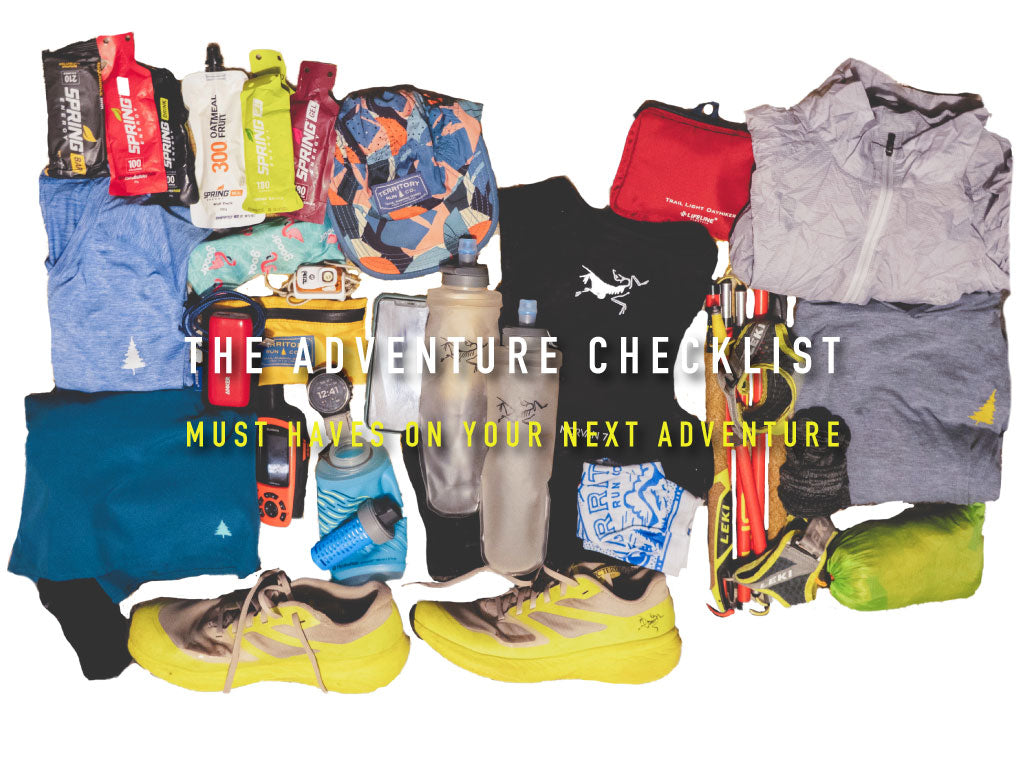Adventure Checklist

Properly packing for a self-supported adventure is significantly more consequential than packing for a race. During a race we can rely on aid stations and volunteers to get us through the effort, but on your own adventure it is crucial that you are prepared for the worst and have thoroughly researched the route. This is not the time to pack light or forgo gear. Weather and conditions can rapidly change and you need contingency plans.
Packing for your adventure should start first with thorough research of your route. What is the weather like? Have you checked with the local land manager regarding current conditions? Where and how frequent are water sources on the route? Where can you bail if you are unable to complete the route?
One tool I utilize for planning an adventure route is Strava. If you look up segments on the route you can sort by the people who have completed it this year. People will often post photos on their activity of what the trail conditions look like. You can also extrapolate the conditions based upon how long it took them to complete sections of the route. This could inform you of impassable sections of the route as well as help you realistically plan how long the route will take to complete.
You should always inform someone of your route beforehand and give them a time you expect to finish. This information can be invaluable should something go wrong on your adventure.
Essential Gear
-
Trail shoes; choose a comfortable pair with good traction for the terrain
-
Moisture Wicking Socks
-
Performance Apparel; lightweight, moisture-wicking clothing suitable for the weather
-
Pack or vest; this will depend on personal preference, distance, and how much you plan to pack
-
Water Bottles or Bladder
-
Water filter or purification tablets; I prefer to use the Hydrapak Filter Cap. This cap goes onto an existing bottle and allows you to fill the bottle and drink straight from the cap. It’s lightweight, simple and effective.
-
Headwrap; this is my secret utility weapon. It can be used to wrap around your ears or nose in cold weather. It can be wrapped around your wrist to be used as a sweatband in warm weather. It can be dipped in water to cool you down in the heat. It can be wrapped around a water bottle to convert it into a handheld bottle. I’ve even used it to stop the bleeding after taking a tumble on the trail.
-
Hat; choose a hat appropriate for the weather.
-
Gloves; regardless of the weather, I will almost always pack at the very least a pair of lightweight gloves
-
Windbreaker; weather can change rapidly and it’s important to be prepared for all possibilities
-
Fully charged phone with .GPX of route loaded; With today’s technology, there really is no reason not to have an offline version of your route saved on your electronic devices.
-
GPS Watch with route loaded; Safety is all about redundancy. Having the route in more than one form is crucial to avert catastrophe. Should your phone die or get lost or damaged, having a backup of the route could save you.
-
Paper map and compass; this could be a third version of the route or the second depending on your watch’s capabilities. Make sure if you are using a paper map, that you know how to read it and navigate with a compass.
-
Sunglasses
-
Food; plan to have about 150-250 calories per hour. Always overpack food in case you are out much longer than anticipated.
-
Sunscreen
-
Trekking poles (optional); You may want poles depending on the terrain. These can also be used for difficult water crossings or if you twist an ankle and need to self-extricate.
Emergency Gear
-
Two-way communication device; it’s very likely that you will not have cell reception on your route. Having an SOS device such as a Garmin InReach could save your life should something go wrong. A satellite tracking device could also suffice, but does not allow for two-way communication to let rescuers know what is wrong.
-
Insulating layer; having an extra layer is important if weather changes or you end up injured or stuck on your route longer than expected.
-
Emergency Bivy; while unlikely, it’s possible you may need to spend the night in the wilderness. An emergency bivy is lightweight and inexpensive. In a catastrophic scenario it can keep you warm while you await rescue.
-
Headlamp; regardless of if I plan to be in the dark or not I will bring a headlamp. If I do not plan to be in the dark, I will pack the Petzl Bindi. It is extremely lightweight and has saved me when nightfall has come unexpectedly.
-
Battery pack with phone cord/ headlamp cord; I always bring an Anker external battery pack with me. They come in various sizes and the smallest ones are extremely lightweight. This can help me charge my phone and also my rechargeable headlamp.
-
First Aid Kit; Always bring a lightweight, fully-stocked first aid kit.